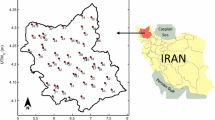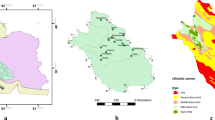Abstract
Droughts can be considered as multidimensional hazardous phenomena characterised by three attributes: severity, duration and areal extent. Conventionally, drought events are assessed for their severity, using drought indices such as SPI (Standardised Precipitation Index), RDI (Reconnaissance Drought Index), PDSI (Palmer Drought Severity Index) and many others. This approach may be extended to incorporate the modelling of an additional dimension, the duration or the areal extent. Since the marginal distributions describing these dimensions of drought are often different, no simple mixed probability distribution can be used for the bivariate frequency analysis. The copula approach seems to be sufficiently general and suitable for this type of analysis. It is the aim of this paper to analyse droughts as two-dimensional phenomena, including drought severity and areal extent. In this paper, the Gumbel-Hougaard copula from the Archimedean family is used for this two-dimensional frequency analysis. Annual data on historical droughts from Eastern Crete are analysed for their severity and areal extent, producing copula-based probability distributions, incorporating Gumbel marginal probability functions. Useful conclusions are derived for estimating the «OR» return period of drought events related to both severity and areal extent.






Similar content being viewed by others
References
Al-Faraj FA, Scholz M, Tigkas D (2014) Sensitivity of surface runoff to drought and climate change: application for shared river basins. Water 6(10):3033–3048
Bacchi B, Becciu G, Kottegoda NT (1994) Bivariate exponential model applied to intensities and durations of extreme rainfall. J Hydrol 155(1–2):225–236
Bazrafshan J, Nadi M, Ghorbani K (2015) Comparison of empirical copula-based joint deficit index (JDI) and multivariate standardized precipitation index (MSPI) for drought monitoring in Iran. Water Resour Manag 29(6):2027–2044
Bonaccorso B, Peres D, Castano A, Cancelliere A (2015) SPI-based probabilistic analysis of drought areal extent in Sicily. Water Resour Manag 29:459–470
Chen L, Singh VP, Guo S, Mishra AK, Guo J (2013) Drought analysis using copulas. J Hydrol Eng 18(7):797–808
Dalezios NR, Loukas A, Vasiliades L, Liakopoulos E (2000) Severity-duration-frequency analysis of droughts and wet periods in Greece. Hydrol Sci J 45(5):751–769
Ganguli P, Reddy J (2012) Risk assessment of droughts in Gujarat using bivariate copulas. Water Resour Manag 26:3301–3327
Genest C, Favre AC (2007) Everything you always wanted to know about copula modeling but were afraid to ask. J Hydrol Eng 12(4):347–368
Genest C, MacKay RJ (1986) Copules archimédiennes et families de lois bidimensionnelles dont les marges sont données. Can J Stat 14(2):145–159
Goel N, Seth S, Chandra S (1998) Multivariate modeling of flood flows. J Hydraul Eng 124(2):146–155
Gupta VK, Duckstein L (1975) A stochastic analysis of extreme droughts. Water Resour Res 11(2):221–228
Hargreaves GH, Samani ZA (1985) Reference crop evapotranspiration from temperature. Appl Eng Agric 1(2):96–99
Huang S, Huang Q, Chang J, Chen Y, Xie Y (2015) Copulas-based drought evolution characteristics and risk evolution in a typical arid and semi-arid region. Water Resour Manag 29(5):1489–1503
Kendall DP, Dracup JA (1992) On the generation of drought events using an alternating renewal reward model. Stoch Hydrol Hydraul 6(1):55–68
Khalili D, Farnoud T, Jamshidi H, Kamgar-Haghighi AA, Zand-Parsa S (2011) Comparability analyses of the SPI and RDI meteorological drought indices in different climatic zones. Water Resour Manag 25(6):1737–1757
Kousari MR, Dastorani MT, Niazi Y, Soheili E, Hayatzadeh M, Chezgi J (2014) Trend detection of drought in arid and semi-arid regions of Iran based on implementation of reconnaissance drought index (RDI) and application of non-parametrical statistical method. Water Resour Manag 28(7):1857–1872
McKee TB, Doesken NJ, Kleist J (1993) The relationship of drought frequency and duration to time scale. Proceedings of the Eighth Conference on Applied Climatology, American Meteorological Society Anaheim (CA), 17–22 January 1993, AMS, pp. 179–184
Mishra AK, Singh VP (2011) Drought modelling - a review. J Hydrol 403(1–2):157–175
Nelsen RB (1999) An introduction to copulas. Springer-Verlag, Berlin - New York
Palmer WC (1965) Meteorological Drought. US Department of Commerce, Weather Bureau, Research Paper No. 45, Washington DC
Reddy MJ, Singh VP (2014) Multivariate modeling of droughts using copulas and meta-heuristic methods. Stoch Env Res Risk A 28(3):475–489
Rossi G, Benedini M, Tsakiris G, Giakoumakis S (1992) On regional drought estimation and analysis. Water Resour Manag 6(4):249–277
Salvadori G, De Michele C, Kottegada NT, Rosso R (2007) Extremes in Nature. An approach Using Copulas. Water Science and Technology Library, Springer, vol. 56
Serinaldi F, Bonaccorso B, Cancelliere A, Grimaldi S (2009) Probabilistic characterization of drought properties through copulas. Phys Chem Earth 34(10–12):596–605
Shiau JT (2006) Fitting drought duration and severity with two-dimensional copulas. Water Resour Manag 20:795–815
Shiau JT, Modarres R (2009) Copula-based drought severity-duration-frequency analysis in Iran. Meteorol Appl 16(4):481–489
Shokoohi A, Morovati R (2015) Basinwide comparison of RDI and SPI within an IWRM framework. Water Resour Manag 29(6):2011–2026
Singh K, Singh VP (1991) Derivation of bivariate probability density functions with exponential marginals. Stoch Hydrol Hydraul 5(1):55–68
Sklar A (1959) Fonctions de répartition à n dimensions et leurs marges. Publ Inst Statist Univ Paris 8:229–231 (in French)
Song S, Singh VP (2010a) Frequency analysis of droughts using the Plackett copula and parameter estimation by genetic algorithm. Stoch Environ Res Risk Assess 24(5):783–805
Song S, Singh VP (2010b) Metaelliptical copulas for drought frequency analysis of periodic hydrologic data. Environ Res Risk Assess 24(3):425–444
Tigkas D, Vangelis H, Tsakiris G (2015) DrinC: a software for drought analysis based on drought indices. Earth Sci Inf 8(3):697–709
Todisco F, Mannocchi F, Vergni L (2013) Severity–duration–frequency curves in the mitigation of drought impact: an agricultural case study. Nat Hazards 65(3):1863–1881
Tsakiris G (2008) Uni-dimensional analysis of droughts for management decisions. European Water 23-24:3–11
Tsakiris G, Vangelis H (2004) Towards a drought watch system based on spatial SPI. Water Resour Manag 18(1):1–12
Tsakiris G, Vangelis H (2005) Establishing a drought index incorporating evapotranspiration. European Water 9-10:3–11
Tsakiris G, Pangalou D, Tigkas D, Vangelis H (2007a) Assessing the Areal Extent of Drought. Proceedings of EWRA Symposium “Water Resources Management: New Approaches and Technologies”, Chania - Greece, 14–16 June 2007, pp. 59–66
Tsakiris G, Pangalou D, Vangelis H (2007b) Regional drought assessment based on the reconnaissance drought index (RDI). Water Resour Manag 21(5):821–833
Tsakiris G, Tigkas D, Vangelis H, Pangalou D (2007c) Regional drought identification and assessment. Case study in Crete. In: Rossi G, Vega T, Bonaccorso B (eds) Methods and tools for drought analysis and management. Springer, The Netherlands, pp. 169–191
Tsakiris G, Tigkas D, Vangelis H (2010) Proactive Management of Water Systems to Face Drought and Water Scarcity in Islands and Coastal Areas of the Mediterranean (PRODIM). In : López-Francos A. (ed), Economics of drought and drought preparedness in a climate change context. Option s Méditerranéennes: Série A. n. 95, CIHEAM, Zaragoza pp. 335–339
Tsakiris G, Nalbantis I, Vangelis H, Verbeiren B, Huysmans M, Tychon B, Jacquemin I, Canters F, Vanderhaegen S, Engelen G, Poelmans L, De Becker P, Batelaan O (2013) A system-based paradigm of drought analysis for operational management. Water Resour Manag 27(15):5281–5297
Tsakiris G, Kordalis N, Tsakiris V (2015) Flood double frequency analysis: 2D-Archimedean copulas vs bivariate probability distributions. Environmental Processes 2(4):705–716
Vangelis H, Spiliotis M, Tsakiris G (2011) Drought severity assessment based on bivariate probability analysis. Water Resour Manag 25(1):357–371
Vangelis H, Tigkas D, Tsakiris G (2013) The effect of PET method on reconnaissance drought index (RDI) calculation. J Arid Environ 88:130–140
Vergni L, Todisco F, Mannocchi F (2015) Analysis of agricultural drought characteristics through a two-dimensional copula. Water Resour Manag 29(8):2819–2835
Wei TC, McGuinnes JL (1973) Reciprocal distances squared method. A computer technique for estimating areal precipitation. U.S. Department of Agriculture, ARS-NS-8, pp. 1–23
Weiss G (2011) Copula parameter estimation by maximum-likelihood and minimum-distance estimators: a simulation study. Comput Stat 26(1):31–54
Wilhite DA, Vanyarkho OV (2000) Drought: Pervasive Impacts of a Creeping Phenomenon. In: Drought: A Global Assessment, Vol. I, Wilhite DA (ed), chap 18, Routledge, London, pp 245–255
Yue S, Quarda TBMJ, Bobée B, Legendre P, Bruneau P (1999) The Gumbel mixed model for flood frequency analysis. J Hydrol 226(1–2):88–100
Yusof F, Hui-Mean F, Suhaila J, Yusof Z (2013) Characterisation of drought properties with bivariate copula analysis. Water Resour Manag 27(12):4183–4207
Zarch MAA, Malekinezhad H, Mobin MH, Dastorani MT, Kousari MR (2011) Drought Monitoring by Reconnaissance Drought Index (RDI) in Iran. Water Resour Manag 25(13):3485–3504
Zelenhastic E, Salvai A (1987) A method of streamflow drought analysis. Water Resour Res 23(1):156–168
Author information
Authors and Affiliations
Corresponding author
Rights and permissions
About this article
Cite this article
Tsakiris, G., Kordalis, N., Tigkas, D. et al. Analysing Drought Severity and Areal Extent by 2D Archimedean Copulas. Water Resour Manage 30, 5723–5735 (2016). https://doi.org/10.1007/s11269-016-1543-z
Received:
Accepted:
Published:
Issue Date:
DOI: https://doi.org/10.1007/s11269-016-1543-z




